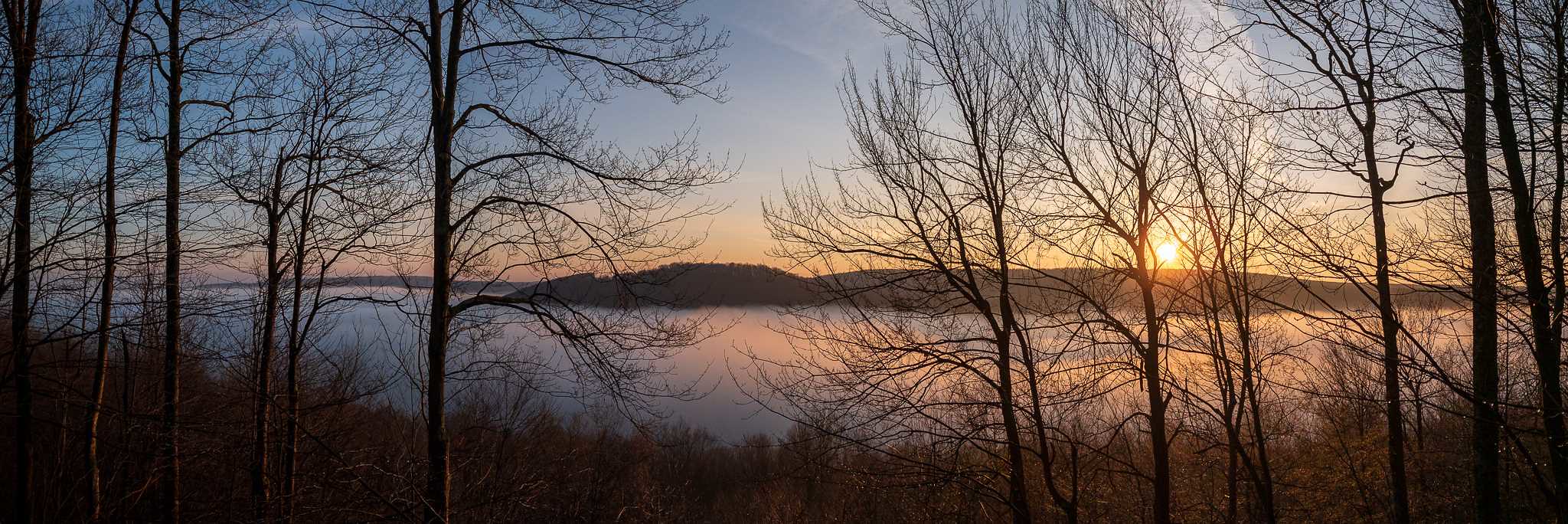
Welcome to Deep Creek Lake NRMA
The Deep Creek Lake Natural Resource Management Area lies just west of the Allegheny Front on a large plateau known as the Tablelands or Allegany Highlands. It lies west of the Eastern Continental Divide and within the Mississippi River watershed. The lake was created in 1925 when the Deep Creek project was constructed by the Youghiogheny Hydroelectric Company. At full pool, Deep Creek, with 65 miles of shoreline, has a surface area of 3,900 acres with a storage volume of approximately 106,000 acre-ft. at the 2,462 elevation level. The lake’s drainage is 64.7 square miles. Currently the water withdrawal from the lake is permitted for the Deep Creek power station and other limited purposes.
Learn more by selecting a topic below.
History
Deep Creek Lake, nestled in Garrett County, Maryland, stands as a testament to both human ingenuity and natural beauty. Managed by the Maryland Department of Natural Resources (DNR), this expansive 3,900-acre reservoir boasts 69 miles of shoreline and reaches depths of up to 75 feet, making it Maryland’s largest inland body of water. Its creation in 1925 by the Youghiogheny Hydroelectric Company transformed the landscape, establishing a hydroelectric project that has since evolved into a hub for recreation, wildlife conservation, and tourism.

The lake's location west of the Allegheny Front places it on the Tablelands plateau, also known as the Allegany Highlands. This positioning situates it within the Mississippi River watershed, specifically at the southernmost end of Meadow Mountain, west of the Eastern Continental Divide. The surrounding area, now Deep Creek Lake State Park, encompasses over 1,800 acres and offers a myriad of recreational activities, including boating, fishing, hiking, and camping.
The history of Deep Creek Lake is rich and multifaceted. Before the lake's formation, the region was characterized by dense forests of red spruce, hemlock, white pine, and yellow birch. In the early 20th century, extensive logging operations cleared much of this virgin timber. The area also holds historical significance with sites like the Brant coal mine and homesite, where a restored mine entrance showcases a typical drift or adit mine, reflecting the region's coal mining heritage.
In 2000, the State of Maryland acquired Deep Creek Lake and its surrounding Buffer Strip from the Pennsylvania Electric Company for $17 million. The DNR was entrusted with its management, focusing on balancing recreational use with environmental preservation and community interests. As we approach 2025, the lake celebrates its 100th anniversary—a century of providing natural splendor and recreational opportunities to countless visitors. For more information on centennial events and the lake's storied past, please visit the DCL100 webpage.
Deep Creek Lake's legacy is one of transformation and stewardship, evolving from a hydroelectric project to a cherished natural resource. Its management continues to prioritize the protection of its ecological integrity while offering diverse recreational experiences, ensuring that it remains a treasured destination for future generations.
Lake Management Office
Address: 73 Brant Road, Swanton, MD 21561
Phone: 301-387-4112
Email:
[email protected]
Office Hours: Monday-Friday 8 am – 4pm
We also conveniently have a drop box that can be used outside of office hours or if staff are in the field.
The Lake Management Office: The Deep Creek Lake Management Office, located at 73 Brant Road, Swanton, MD 21561, serves as the central hub for information dissemination, permit processing, and regulatory enforcement concerning Deep Creek Lake and its surrounding Buffer Strip. As part of Maryland's state park system, the office is dedicated to preserving the lake's ecological integrity while facilitating public enjoyment. The team manages various permits, including Buffer Strip Use Permits and Special Permits, ensuring that all activities align with the Code of Maryland Regulations (COMAR) to protect the lake's natural and recreational resources. For inquiries or assistance, the office can be reached at 301-387-4112 or via email at
[email protected].
Back to Top
Regulations and Permits
Jump to: Regulations |
Permit Types
COMAR
COMAR (Code of Maryland Regulations) is the official compilation of all administrative regulations issued by state agencies in Maryland. It serves as the legal framework for implementing laws and policies in various sectors, including natural resource management. These regulations are binding and ensure that activities under the jurisdiction of state agencies comply with established laws and guidelines. For Deep Creek Lake, COMAR outlines the rules and policies that govern the management, use, and conservation of the lake and its surrounding state-owned Buffer Strip. The Maryland Department of Natural Resources (DNR) administers these regulations to balance recreational use, private property rights, and environmental preservation.
Key COMAR chapters applicable to DCL include:
COMAR .08.08 – Deep Creek Lake Regulations
- Governs activities on the lake and Buffer Strip for both private and commercial property owners.
- Establishes rules for dock installations, Buffer Strip use, and private property adjacent to the lake.
COMAR .08.07 – State Park Regulations
- Applies to the recreational use of Deep Creek Lake and its Buffer Strip as part of Maryland's state park system.
- Includes guidelines for public access, camping, and other recreational activities.
By adhering to COMAR, the DNR ensures sustainable use of Deep Creek Lake, protects its natural resources, and provides a fair framework for property owners, recreational users, and the general public. The regulations help preserve the lake as a valuable resource for future generations while addressing the diverse needs of the community.
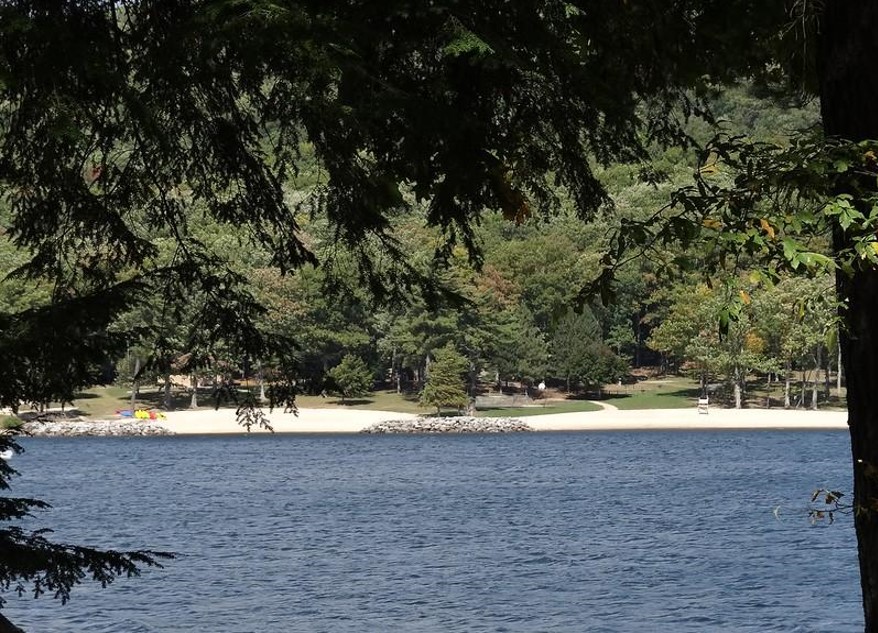
Regulations and Land Use Information
Deep Creek Lake is governed by a comprehensive set of regulations outlined in the Code of Maryland Regulations (COMAR), which ensures proper use and management of the lake and its surrounding Buffer Strip. These include COMAR .08.08, which specifically regulates the activities of private and commercial property owners adjoining the lake. As part of Maryland’s state park system, additional rules under COMAR .08.07 govern recreational use of the lake and Buffer Strip. Permits or written letters of approval are required for various activities involving the Deep Creek Lake Buffer Strip and Conservation Easement parcel and are outlined in the next section.
Who Needs a Permit?
Permits are required for various activities involving the Deep Creek Lake Buffer Strip and state-managed property. Listed below are a number of informational materials and application forms that may be used by property owners and other permitted users of the State-owned Buffer Strip around Deep Creek Lake. Simply "click" on the underlined guidelines or forms that you are interested in reading or downloading and completing.
Types of Permits
Buffer Strip Use Permit: Adjacent property owners must obtain a Buffer Strip Use Permit to enjoy recreational privileges beyond those available to the general public, including installing and maintaining docks.
This application is also necessary for new property owners if the previous owner held a dock permit. If you already have a copy of the deed,
use this version of the form.
Special Permit: A Special Permit is needed for activities such as tree plantings, conducting maintenance on state property, making non-permanent improvements, or establishing structures like walkways, sheds or gazebos. These permits also apply to commercial activities on the Buffer Strip.
Use this application to apply for a permit. Permittees may also apply for a special permit for benthic mats to aid in submerged aquatic vegetation management by using this application.
Development Permit: Property owners planning to develop or subdivide their land must
apply for a Development Permit. This permit provides concept approval for the use of park property and governs Buffer Strip use and docking facilities.
Conservation Easements: Additionally, property owners involved in Conservation Easements must follow strict guidelines controlling land use and maintenance. Those planning improvements or maintenance on state-managed land may need to submit
applications for Conservation Easement Alterations Application (CEAA). These permits come with clearly defined conditions designed to protect the lake’s natural resources.
For further guidance, permit applications, or assistance with compliance, property owners and visitors are encouraged to contact the Deep Creek Lake Management Office at 301-387-4112 or consult with a Lake Management teammate.
2025 Deep Creek Lake NRMA fees:
- House rental fee - $70
- Special Permit - $70
- Mooring Buoy - $70
- Misc Use (no dock) - $70
- Type A- $200
- Common BSUP- $160/slip
- Commercial Permit - $200/slip
- Commercial Transient $160/slip (parking for businesses)
- Dock Slip Rental - $200
Back to Top
Inspections and Compliance
The Deep Creek Lake Management Office conducts regular inspections to ensure compliance with regulations governing the state-owned Buffer Strip and associated areas. These inspections are vital for maintaining the environmental integrity and recreational quality of Deep Creek Lake.
Inspection Procedures:
-
Random Inspections: Annually, starting in October (beginning September 2024), the Lake Management team aims to inspect 15–20 miles of continuous state property. These inspections inventory recreation-related facilities on the Buffer Strip and waters of Deep Creek Lake, identifying any violations of lake regulations.
-
Response to Requests: The office operates Monday through Friday, 8 AM to 4 PM, with a standard two-week turnaround for all requests. If staff are unavailable, visitors are encouraged to leave a note for follow-up.
-
Review Process: Conservation Easement Alteration Applications (CEAA) are reviewed by the Policy and Review Board (PRB) before approval. This process can take up to two weeks, depending on the PRB's response. Special Permits, which have a $70 fee, are reviewed internally by the office.
Common Violations Noted During Inspections:
-
Unauthorized Structures: Erecting unapproved or non-compliant structures, such as sheds, gazebos, or docks, on the Buffer Strip without the necessary permits.
-
Improper Seasonal Removal: Failing to remove items that do not require a Special Permit—such as removable fire rings, grandfathered jet ski ramps, and unblocked ropes—from the Buffer Strip parcel between December 1st and March 15th.
-
Unauthorized Vehicle Use: Operating motorized vehicles outside designated areas is prohibited. Driving on the Buffer Strip is permitted only twice a year for dock deployment and retrieval by the permit holder or their hired contractor using rubber-tracked machinery. Special exceptions can be granted through the issuance of a special permit. Golf carts are allowed on the Buydown Parcel, if applicable, but must stop at the buydown line. An ADA Permit is required to drive and park on the Buffer Strip at no additional cost and may be obtained by submitting a Special Permit Application and a copy of the Universal Disabilities Pass.
-
Camping and Fire Violations: Camping on the Buffer Strip is prohibited. Fire rings must have an inside diameter of 3 feet or less to discourage large fires and be approved by Special Permit. Completely removable fire rings do not require a Special Permit and must be removed seasonally between December 1 and March 15.
-
Shoreline Erosion Control Issues: Constructing shoreline erosion control walls without following proper procedures, using approved contractors, or adhering to guidelines. Grant funding for such projects may be available but is subject to change.
-
Non-Compliance with Notices of Violation (NOV): Properties with violations are issued an NOV. Failure to address these violations can result in the denial of the next year's Buffer Strip Use Permit until corrections are made.
Addressing Violations:
-
Notice of Violation (NOV): Issued to properties found in violation during random inspections, eligibility letter requests, site visits, or general property inspections. Once an NOV is issued, it is recorded internally. Permit renewal is contingent upon resolving these violations.
-
Assistance: The Lake Management Office is available for meetings or to answer questions to help property owners address and correct violations.
Shoreline Erosion Control Wall
To address shoreline erosion at Deep Creek Lake, property owners must follow a permitting process involving both the Maryland Department of the Environment (MDE) and the Deep Creek Lake Management Office. This process includes submitting applications, obtaining necessary approvals, and adhering to specific guidelines to ensure environmental protection and compliance with state regulations.
Below is a step-by-step guide outlining the necessary procedures:
-
Initial Inquiry: Contact the Deep Creek Lake Management Office to schedule an on-site meeting with staff. This consultation will help assess the specific needs and feasibility of the proposed SEC wall.
-
Application Submission: Complete and submit two applications:
- The Maryland Department of the Environment (MDE) Waterways Obstruction Permit Application.
- The Deep Creek Lake Management Special Permit Application.
-
Lake Management Review: Provide seven copies of the MDE permit application to the Lake Management Office. The Lake Manager will review and sign the application as the representative of the state, which owns the lake and surrounding buffer strip.
-
Submission to MDE: The Lake Management Office will forward the signed application to MDE for review. MDE's review period is a minimum of 45 days and may extend if additional information or modifications are required.
-
MDE Permit Fee: Upon submission, the property owner or contractor must send a $250 check to MDE as the permit processing fee.
-
MDE Approval: Once MDE approves the permit, copies will be sent to both the property owner (or contractor) and the Lake Management Office.
Back to Top
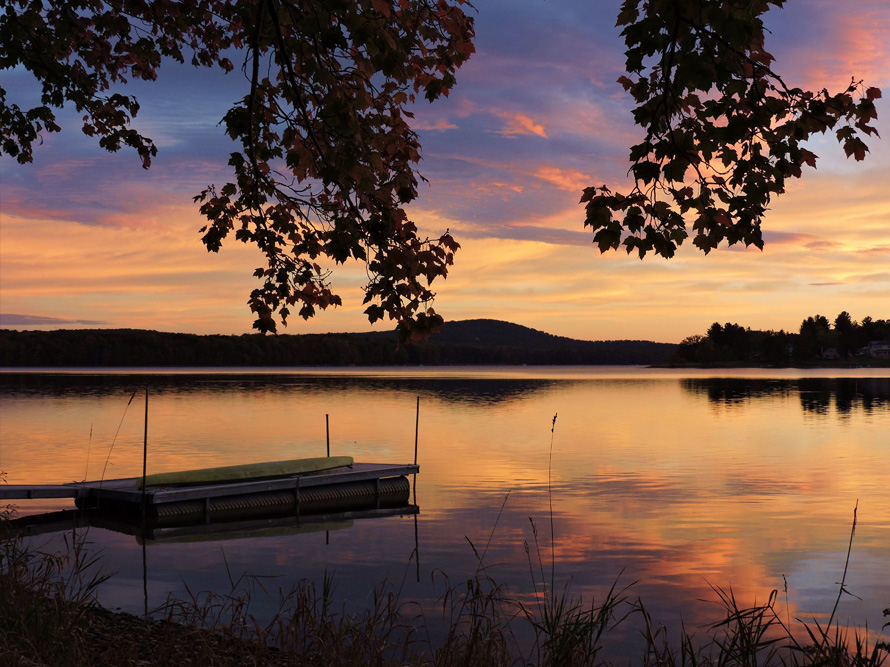
Recreational Activities
Jump to: Boating |
Fishing |
Hunting
BOATING
Ensuring safe and enjoyable boating experiences on Deep Creek Lake requires adherence to specific regulations and a commitment to boater education. The Maryland Department of Natural Resources (DNR) and the Natural Resources Police (NRP) oversee these regulations to promote safety and environmental stewardship.
COMAR .08.18.33 – Deep Creek Lake Boating Regulations
- Defines rules for operating watercraft on Deep Creek Lake.
- Includes safety requirements, speed limits, and designated zones for boating activities.
COMAR .08.18.02 – Statewide Personal Watercraft Regulations
- Provides additional rules specific to the use of personal watercraft (e.g., jet skis) on the lake.
Boater Education Requirements:
- Individuals born on or after July 1, 1972, must possess a valid boating safety certificate to operate a vessel on Maryland waters. This certificate can be obtained by completing a boating safety course approved by the DNR.
Vessel Specifications:
- The maximum allowable length for vessels on Deep Creek Lake is 26 feet. However, pontoon boats may extend up to 30 feet in length, including the motor.
- Engines must not exceed the manufacturer's recommended maximum horsepower capacity or have a total displacement greater than 550 cubic inches.
- Houseboats are prohibited on the lake.
Personal Watercraft (PWC) Regulations:
- Operation of PWCs is restricted between 11 a.m. and 4 p.m. on the Saturday, Sunday, and holiday of Memorial Day weekend, as well as on Saturdays, Sundays, and state holidays from July 1 through Labor Day.
- Operators of PWCs must be at least 16 years old.
Safety Equipment and Practices:
- All vessels must carry the required safety equipment, including U.S. Coast Guard-approved life jackets for each person on board.
- Children under 13 years of age are required to wear a life jacket while underway on a recreational vessel under 21 feet in length.
- Anyone being towed behind a vessel on water skis or any other device must wear a Type I, II, or III flotation device.
- Towing individuals is prohibited between sunset and sunrise.
Operational Restrictions:
- Vessels must operate at no-wake speed when within 100 feet of the shoreline, bridges, piers, docks, or other vessels.
- Parasailing and similar activities that cause individuals to become airborne are not permitted on the lake.
Buoy Markings on Deep Creek Lake:
The DNR positions buoys on Deep Creek Lake to mark hazards, designate public swimming areas, and indicate speed zones. Understanding these markers is crucial for safe navigation:
-
Hazard Buoys: Indicate rocks, tree stumps, shallow areas, or other dangers.
-
No-Wake Zone Buoys: Signify areas where vessels must operate at idle speed to prevent wake.
-
Swimming Area Buoys: Mark designated swimming zones where vessel entry is prohibited. Deep Creek Lake State Park is currently the only designated public swimming area on the lake.
Boaters are advised to familiarize themselves with these markers and adhere to the guidelines they represent. For a comprehensive understanding of navigational aids, refer to the U.S. Coast Guard's brochure on waterway markers.

FISHING
Deep Creek Lake, Maryland's largest inland body of water, offers anglers a diverse and rewarding fishing experience year-round. The lake's 3,900 acres and 65 miles of shoreline are home to various fish species, making it a prime destination for novice and seasoned fishermen.
Anglers at Deep Creek Lake can expect to encounter a range of species, including:
- Largemouth and Smallmouth Bass
- Walleye
- Yellow Perch
- Bluegill
- Brown and Rainbow Trout
Fishing Regulations - To maintain healthy fish populations, specific regulations are enforced:
- Walleye:
- Minimum size limit of 15 inches year-round.
- Protected slot between 18 and 21 inches; all fish within this slot must be released.
- Season is open year-round, except from March 1 through April 15 on Deep Creek Lake and the Youghiogheny River downstream of Route 42 bridge.
- Daily creel limit of 5 fish; possession limit of 10.
- Largemouth and Smallmouth Bass:
- Minimum size limit of 12 inches.
- Open season from June 16 to the last day of February.
- Daily creel limit of 5 fish in aggregate; possession limit of 10 in aggregate.
- Catch and release is permitted at all times.
- Northern Pike:
- Minimum size limit of 30 inches.
- Open year-round.
- Daily creel limit of 2 fish; possession limit of 4.
- Yellow Perch:
- No minimum size limit in nontidal lakes and ponds.
- Open year-round.
- No daily creel or possession limits.
- Trout:
- No minimum size limit.
- Open year-round.
- Daily creel limit of 2 fish in aggregate; possession limit of 4 in aggregate.
- Different rules apply for Put-and-Take Areas and Special Trout Management Areas.
- Fishing License:
Anglers are encouraged to familiarize themselves with the latest regulations to ensure compliance.
Access Points - Public access for fishing is available at several locations:
- Deep Creek Lake State Park:
- Offers over one mile of lake access.
- The boat ramp is open 24 hours per day and during the summer has an ADA fishing pier.
- Fishing from the Discovery Center docks is permitted.
- The sandy portion of the swim beach and the ranger docks are the only areas anglers are asked to avoid.
- The park closes at sunset, but night fishing is permitted by parking in the Ranger Station parking lot or at the boat ramp.
- Ice fishing is permitted but DNR does not monitor ice thickness. Anglers wanting to ice fish shall do so at their own risk.
- Near the 219 Bridge:
- There is a small parking area where anglers can expect to catch crappie, chain pickerel, largemouth bass, smallmouth bass, and walleye.
- This location is open 24 hours a day.
- Buffer Strip Access:
- Anglers may fish along the entire shoreline provided they legally access the state-owned Buffer Strip.
- Docks are private property; fishing from a dock without written permission is prohibited.
- Anglers are reminded to be respectful by not leaving any litter or debris behind.
Respect for private property is essential; always use designated public access points or obtain permission from landowners.
Seasons and Conditions- Fishing at Deep Creek Lake is productive throughout the year:
- Spring and Summer
- Ideal for bass and panfish, with warmer waters bringing fish into shallower areas.
- Fall
- Cooling temperatures can lead to increased activity among species like walleye and pike.
- Winter
- Ice fishing is popular, targeting species such as yellow perch and bluegill.
- The Department of Natural Resources does not monitor ice thickness; anglers should exercise caution and fish at their own risk.
Always check current conditions and ice thickness during winter months to ensure safety.
Additional Resources:
For the most up-to-date information on fishing conditions, regulations, and licenses, visit the Maryland DNR's official website.
HUNTING
Hunting at Deep Creek Lake is regulated to balance recreational opportunities with environmental conservation and public safety. General hunting is prohibited on the Buffer Strip surrounding the lake, with the exception of a managed Canada goose hunt. However, designated areas within Deep Creek Lake State Park are open for public hunting during specific seasons.
Managed Waterfowl Hunt
Special Hunts: Since 2015, the Maryland Department of Natural Resources (DNR) has conducted managed waterfowl hunts, with a focus on Canada geese, to assist in population control. These hunts typically occur over a three-day period in November and are by permit and reservation only. Participants can apply to hunt at designated blind sites on Deep Creek Lake and Broadford Lake. During the hunt, participants must stay within 50 feet of the stake or buoy marking the designated blind site, except when retrieving game.
DCL NRMA and Broadford Lake Lottery Application
Regulations and Safety
Compliance: All hunters must comply with state hunting regulations, including licensing requirements, season dates, and bag limits. It's crucial to recognize all hunting regulations and seasons and to keep all weapons unloaded until within a designated hunting area. Additionally, hunters should be aware of other recreational users in the area and exercise caution to ensure everyone's safety.
Designated Hunting Areas
Deep Creek Lake State Park: The park offers a 551-acre designated hunting area, marked with managed hunting area signs. Hunters can access this area by parking at the Ranger Station, various pull-offs on State Park Road, and the Cherry Creek parking lot. It's important to adhere to all hunting regulations and seasons, and to keep weapons unloaded until within the designated hunting area. Additionally, hiking and mountain biking trails traverse parts of the hunting area, so hunters should remain alert and respectful of other trail users.
Back to Top
Environmental Initiatives
A video a produced by the Maryland Department of Natural Resources designed to educated boaters and anglers on how to stop the spread of invasive species in Maryland's waters.
Hydrilla Control Program
In 2013, Maryland Department of Natural Resource biologists discovered hydrilla – a fast-growing invasive weed that can negatively impact recreational opportunities in the southern portion of Deep Creek Lake. The department convened a nationwide expert panel to evaluate all potential hydrilla control strategies and implemented a multi-year herbicide program. Since 2014, the department has been treating the lake bottom where hydrilla has been found with small amounts of herbicide each year to exhaust all of the tubers (reproductive structures that generate new plants). The treatment program has been successful since its inception in 2014 and is planned to continue during the summer of 2025.
The four herbicide treatment dates will begin in June. Treatments are usually conducted on Tuesdays, however dates are subject to change due to weather conditions. The dates are posted below. The department encourages lake residents to
sign up for email updates. For questions about the Hydrilla Control Program, please contact the Lake Management Office at
[email protected] or 301-387-4112.
Submerged Aquatic Vegetation
Back to Top
Marinas
Marina Regulations at Deep Creek Lake
Marinas on Deep Creek Lake must comply with the Code of Maryland Regulations (COMAR) and local county regulations to operate and manage their facilities effectively. These regulations ensure marina operations align with environmental conservation goals, recreational needs, and community standards.
Key Regulations and Requirements
County and State Compliance
- Marinas must meet all applicable Garrett County regulations for a full-service marina, including zoning, development, and operational standards.
- State-specific regulations under COMAR .08.08 govern marina activities and property use on state-owned Buffer Strips and the lake itself.
Development Permits
- Marina property owners are required to apply for a Development Permit to establish or expand marina operations.
- This permit determines the number of slips (dock spaces) that a marina can accommodate based on factors like environmental impact and waterway capacity.
Buffer Strip Use Permits
- Marinas must obtain Development Permit to operate on state-owned land adjacent to the lake.
- This permit authorizes specific uses, such as dock installation and other non-permanent improvements, within the Buffer Strip area.
Special Permits for Additions
- Any additions or modifications to a marina’s business within the Buffer Strip (e.g., building new docks or installing non-permanent structures) require a Special Permit.
- Applications for Special Permits must comply with COMAR guidelines and undergo a two-week public comment period to ensure transparency and community involvement.
Environmental Protection
- Marina operations are subject to regulations that protect water quality and prevent shoreline erosion.
- Facilities must implement best practices for managing runoff, maintaining vegetation, and adhering to erosion control guidelines.
Public Access and Use
- Marinas may have specific requirements to ensure that public access to certain areas of the Buffer Strip or water is not obstructed.
Relevant COMAR Chapters
- COMAR .08.08 – Deep Creek Lake Regulations: Governs marina activities, including dock installations and Buffer Strip use.
- COMAR .08.18.33 – Boating Regulations: Establishes rules for marina-related boating activities, including slip allocations and boating safety requirements.
Back to Top
General Public Access
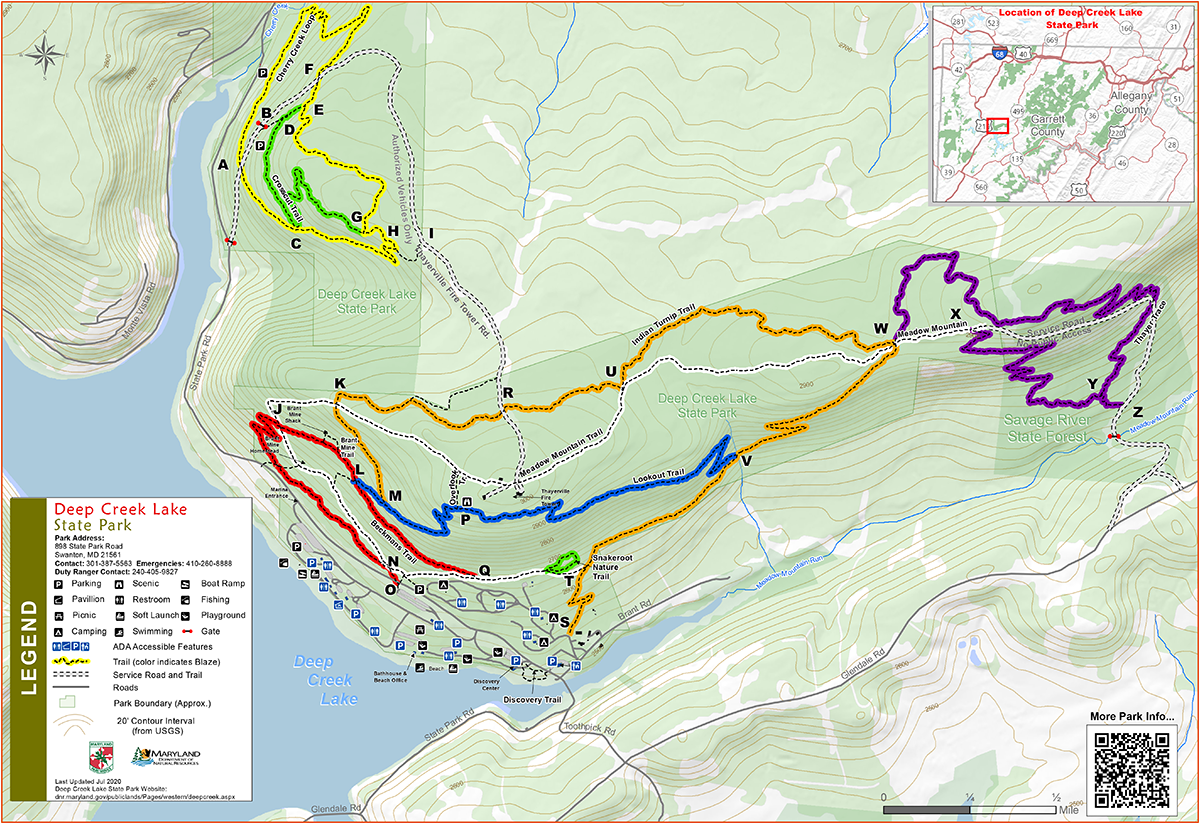
Deep Creek Lake offers several designated access points for the general public to enjoy its natural beauty and recreational opportunities. Notably, the
Deep Creek Lake State Park provides a public boat launch facility, which serves as the primary access point for boaters. A launch fee is required and can be paid through an honor-box located adjacent to the ramp.
In addition to the state park, public access to the Buffer Strip is available at the bridge at Cherry Creek Cove and the state-owned area located at the U.S. Route 219 Bridge. These access points allow visitors to walk along the Buffer Strip and engage in shoreline fishing. It's important to note that while the general public is permitted to traverse and fish from the Buffer Strip, accessing the lake through private property is prohibited unless explicit permission is granted by the property owner. Furthermore, the use of private docks or any improvements made by adjacent landowners is not allowed without proper authorization. Prohibited uses include camping, picnicking, biking, boating and swimming (COMAR 08.08.03.01.C).
For those interested in fishing, Deep Creek Lake is home to a variety of species, including trout, walleye, bass, and yellow perch. The lake is stocked regularly, and fishing is available year-round. Public fishing docks, which are wheelchair accessible, are located at Deep Creek Lake State Park, providing convenient spots for anglers to cast their lines.
Visitors are encouraged to familiarize themselves with the specific regulations governing the use of the Buffer Strip and lake to ensure a safe and enjoyable experience for all.
Back to Top
Realtors, Buyers, and Sellers and Contractors
For real estate professionals and contractors working with Buffer Strip Use Permit (BSUP) holders around Deep Creek Lake, it's essential to understand the regulations and procedures governing property use and modifications. This guide provides an overview to assist in navigating these requirements effectively.
Buffer Strip Use Permits (BSUP):
A BSUP is an annual permit issued to lakefront property owners or homeowners' associations owning lake access common areas. This permit authorizes the placement of specific types of boat docks on Deep Creek Lake in front of their property. All docks must be removed from the lake by December 1 each year and may be reinstalled starting March 15.
Special Permits and Conservation Easement Alterations:
Property owners intending to make improvements or conduct maintenance on the Buffer Strip must obtain the appropriate permits:
-
Special Permit: Required for activities such as maintenance, erecting structures like sheds or gazebos, and conducting commercial activities on the lake or Buffer Strip.
-
Conservation Easement Alteration Application (CEAA): Necessary for any alterations within conservation easement areas. All work must adhere to the guidelines set forth by the Maryland Department of Natural Resources (DNR).
General Conditions for Alterations:
- Any alteration or improvement must occur within the area of use of the Permit holder, allow for public access across the Buffer Strip, be non- permanent, be installed, maintained, and removed with minimum disturbance to the land, trees, and vegetation, and be located at least 20 feet upland from the high-water mark (2,462 feet above sea level, where the water meets the shoreline when the lake is at full pool).
-
Structures (Decks, Sheds, Gazebos, etc.):
- Maximum size: 120 sq ft; maximum height: 12 ft.
- Must use natural or earth-toned materials.
- Should not restrict public access.
-
Stairs and Walkways:
- Maximum width: 4 ft; path clearing limit: 10 ft width, 10 ft height.
- Must minimize disturbance and preserve vegetation.
- Handrails must have a 2 ft break to allow public access on the Buffer Strip.
-
Electrical Work:
- All work must comply with the National Electric Code.
- Limit lights to dock pathways, shielded and directed downwards.
-
Landscaping/Vegetation:
- Only native species are allowed.
- DCL Management approval is required for trimming or removal.
- Cutting of vegetation for building placement is limited to plants 3 feet in height or less.
-
Play Areas:
- Sand area maximum size: 400 sq ft, enclosed with treated timbers, filter cloth under sand, permitted only on <5% slope.
- Swings and hammocks must be freestanding.
-
Fire Rings:
- Made of stone, steel, or masonry with an inside diameter of 3 ft or less.
- Long-term storage of firewood is not permitted on state land.
Common Violations:
- Unapproved and noncompliant structures, walkways, lighting, etc.
- Debris include ash, excessive firewood, vegetation trimmings, dock material, etc.
- Unapproved removal or trimming of vegetation.
- Hardware in trees or unblocked rope tied around trees.
- Improper display of dock tags—two plates must be displayed, one facing the shoreline, and one facing the lake.
Buying/Selling Property:
For lakefront properties at Deep Creek Lake, BSUPs allow property owners to install and maintain docks. These permits are non-transferable when a property changes ownership. A new owner must apply for a permit after purchasing a property. To assist in the sale of lakefront properties, sellers and realtors acting on behalf of the seller can request an Eligibility Letter from the Deep Creek Lake Management Office using this
Realtor Authorization Form. This letter confirms whether the property is eligible for a dock permit at the time of sale. When an eligibility letter is requested, field technicians from the Deep Creek Lake Management Office will inspect the property to ensure it is in compliance with both Maryland state regulations and Deep Creek Lake guidelines. If the property is in compliance and there are no violations, the office will issue a Dock Eligibility Letter. Realtors can then provide this letter to potential buyers to verify that the property is eligible for a future dock permit.
Contractor Guidelines:
Contractors performing work on properties with BSUPs must ensure all activities comply with DNR regulations. This includes obtaining necessary permits for construction, adhering to structure size and material restrictions, and preserving native vegetation. Unauthorized alterations or maintenance can result in violations and penalties. It's advisable for contractors to consult with the Deep Creek Lake Management Office before commencing any work.
Additional Resources
Deep Creek Lake, Maryland's largest freshwater lake, is a vital ecological and recreational resource. To ensure its health and sustainability, the Maryland Department of Natural Resources (DNR) has been conducting comprehensive water quality monitoring since April 2009.
This program involves regular sampling at various mainstem and cove locations, assessing parameters such as water temperature, pH, dissolved oxygen, and nutrient levels. The collected data is instrumental in guiding management practices aimed at preserving the lake's water quality. For detailed information and access to monitoring reports, please visit the
Eyes on Deep Creek Lake website.
Back to Top
The Deep Creek Watershed Foundation

Our Focus is to Preserve and Protect the Deep Creek Watershed
The Deep Creek Watershed Foundation (DCWF) is a 501 (c) 3 non-profit organization founded in 2016 with the primary goal of raising funds to finance projects and initiatives to further implement the Watershed Management Plan which will preserve and protect the Deep Creek Watershed. The DCWF has an all-volunteer Board of Directors as well as a very supportive group of Advisors and Volunteers who assist the board in a wide variety of ways.
Our Mission
To support, promote and advance scientific study, environmental protection and educational programs relating to the Deep Creek Watershed. Supporting our mission the Foundation is formed to support the Plan’s goal of “improving the environmental stability and economic viability of the Deep Creek Watershed while retaining its rural landscapes and natural beauty, so that, for generations to come, local citizens and visitors have a special place to live, work, and play.” The Foundation will accomplish this goal by engaging in fundraising activities to sponsor educational programs supporting initiatives relating to the watershed, soliciting and providing funding to support scientific, environmental, and educational programs relating to the watershed, and applying for grants relating to activities in furtherance of the protection of the watershed.
Bob Hoffmann, President of the DCWF, shares why we have a foundation and how we work
(2.5 min video)
Our Projects are Making a Positive Difference
The dynamic partnerships, especially with DNR, established by the Deep Creek Watershed Foundation keep expanding to pay for the increased sustainability of the Deep Creek Watershed.
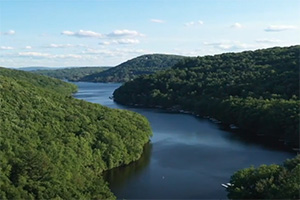
NEW! Groundwater Recharge and Completion of the Water Budget Model
Learn more!
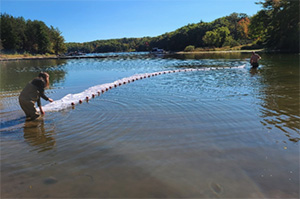
Install and Maintain Water Levels & Temperature Gauges
Learn more!
For More Information on the Foundation, Projects and Successes, please visit:
Back to Top
Water Levels and Water Quality Reports
Water Levels
Maryland Department of the Environment (MDE)
Water Quality Reports
Back to Top
Nuisance Wildlife
Encountering wildlife is a common experience around Deep Creek Lake, and while many interactions are harmless, situations involving nuisance or distressed animals can arise. The Maryland Department of Natural Resources (DNR) provides
several resources to assist residents and visitors in these instances:
Nuisance Wildlife: For concerns about animals causing property damage or posing safety risks, contact DNR’s Wildlife Service at 1-877-463-6497. Operators are available Monday through Friday, 8:00 a.m. to 4:30 p.m., excluding state holidays.
Injured, Sick, or Orphaned Wildlife: If you encounter wildlife that appears injured, ill, or abandoned, it's important not to intervene directly, as untrained handling can be harmful to both humans and animals. Instead, reach out to licensed wildlife rehabilitators through the same Wildlife Service hotline at 1-877-463-6497. They can provide guidance on appropriate actions.
General Wildlife Inquiries: For other wildlife-related questions or to report non-urgent issues, contact the DNR Wildlife and Heritage Service at 410-260-8540 during regular business hours.
Back to Top
Resources and Partnerships
Forthcoming
Back to Top
Policy and Review Board
The Deep Creek Lake Policy and Review Board (PRB) serves as an advisory body to the Maryland Department of Natural Resources (DNR) on issues concerning lake fees, budgeting, and overall management of Deep Creek Lake. Established with a mandate to ensure the sustainable use and protection of the lake's natural and recreational resources, the PRB collaborates closely with the DNR to develop and implement comprehensive plans, such as the Deep Creek Lake Recreation and Land Use Plan, as one of the statutory boards and commissions authorized by the Governor or General Assembly.
In addition to its advisory role to the DNR, the PRB also engages directly with the Maryland Department of the Environment (MDE) on matters pertinent to the lake's environmental health and regulatory compliance. This collaboration ensures that policies and actions affecting Deep Creek Lake are well-coordinated across relevant state agencies.
The PRB comprises members representing various stakeholders, including local residents, business owners, and government officials, reflecting a broad spectrum of interests in the lake's welfare. Regular meetings are convened to discuss ongoing projects, address emerging concerns, and review policy proposals, following these protocols (link below). These meetings are open to the public, fostering transparency and community involvement in decision-making processes. Below are past meeting minutes as well as upcoming meetings and agendas. To learn more, read the Executive Summary and the Land Use Plan (both are linked below).
Meeting Announcement
PRB Meeting: January 26, 2026
PRB Meeting: April 27, 2026
PRB Meeting: July 27, 2026
PRB Meeting: October 26, 2026
Background
The PRB is charged with advising the Department of Natural Resources (DNR) on matters relating to lake fees, budget and management. In addition, the PRB and DNR were mandated to issue a Deep Creek Lake Recreation and Land Use Plan by June 2001 that provides for the wise use, protection and management of the natural and recreational resources of Deep Creek Lake. The Executive Summary and the Plan are available by clicking on the links below.
Upcoming Meetings
Deep Creek Lake Policy and Review Board Meeting Monday, Jan 26, 2026 · 6–8 PM
Google Meet joining info Video call link:
https://meet.google.com/ncf-dkjq-oio
Or dial: +1 405-346-8195 PIN: 266226424
More phone numbers:
https://tel.meet/ncf-dkjq-oio?pin=9655796649593
Deep Creek Lake Policy and Review Board Meeting Monday, May 27, 2026 · 6–8 PM
Google Meet joining info Video call link:
https://meet.google.com/ncf-dkjq-oio
Or dial: +1 405-346-8195 PIN: 266226424
More phone numbers:
https://tel.meet/ncf-dkjq-oio?pin=9655796649593
Deep Creek Lake Policy and Review Board Meeting Monday, Jul 27, 2026 · 6–8 PM
Google Meet joining info Video call link:
https://meet.google.com/ncf-dkjq-oio
Or dial: +1 405-346-8195 PIN: 266226424
More phone numbers:
https://tel.meet/ncf-dkjq-oio?pin=9655796649593
Deep Creek Lake Policy and Review Board Meeting Monday, Oct 26, 2026 · 6–8 PM
Google Meet joining info Video call link:
https://meet.google.com/ncf-dkjq-oio
Or dial: +1 405-346-8195 PIN: 266226424
More phone numbers:
https://tel.meet/ncf-dkjq-oio?pin=9655796649593
Contact Info
Questions, comments and communications for the Policy and Review Board may be directed to
[email protected] or to the Policy and Review Board, Deep Creek Lake Management Office, 873 Brant Road, Swanton, MD 21561.
Back to Top
News and Updates
-
Hydrilla Control Program Updates
Back to Top
Fast FAQs
General Information
What is the size of Deep Creek Lake?
Deep Creek Lake is Maryland's largest freshwater lake, covering approximately 3,900 acres with 65 miles of shoreline.
When was Deep Creek Lake created?
The lake was created in 1925 by the Youghiogheny Hydroelectric Company.
Lake Management, Regulations and Permits
Who manages Deep Creek Lake?
The Maryland Department of Natural Resources (DNR) owns and manages Deep Creek Lake, including the surrounding Buffer Strip. DNR also oversees decisions for improvement on the conservation easements around the lake.
What is the Buffer Strip?
The Buffer Strip is the state-owned land surrounding Deep Creek Lake, managed by the DNR to protect the lake's environmental and recreational qualities.
What is the conservation easement?
Conservation Easements may be present between the buffer strip and homeowners parcels. Property owners involved in Conservation Easements must follow strict guidelines controlling land use and maintenance. Those planning improvements or maintenance on state-managed land may need to submit applications for alterations.
Do I need a permit to use the Buffer Strip?
Yes, a Buffer Strip Use Permit (BSUP) is required for activities such as installing docks or making improvements on the Buffer Strip.
What is a Buffer Strip Use Permit (BSUP)?
A BSUP is an annual permit issued to lakefront property owners or homeowners' associations, authorizing the placement of specific types of boat docks on Deep Creek Lake in front of their property.
Are BSUPs transferable when selling property?
No, BSUPs are non-transferable. New property owners must apply for a permit after purchasing a property.
What is a Special Permit?
A Special Permit is required for activities such as cutting trees or brush, maintenance, erecting structures like sheds or gazebos, and conducting commercial activities on the lake or Buffer Strip.
What is a Development Permit?
A Development Permit is needed for property owners who plan to develop or subdivide their land. It provides approval for the use of park property, as well as for Buffer Strip use and docking facilities.
Can I install a dock if the property has no BSUP?
No, a BSUP is required for dock installation. If the property does not have one, the new property owner must apply for it.
How long does it take to get a permit?
The typical permit review process takes about two weeks, but may take longer depending on the complexity of the application.
What happens if my permit application is denied?
If your application is denied, the Lake Management Office will provide guidance on how to rectify the issues. You can then reapply once the necessary corrections have been made.
Boating Regulations
What are the boat size limits on Deep Creek Lake?
Vessels are limited to a maximum length of 26 feet, except for pontoon boats, which may be up to 30 feet in length, including the motor.
Are there specific operating hours for personal watercraft (PWC)?
Yes, PWC operation is restricted between 11 a.m. and 4 p.m. on Memorial Day weekend and on Saturdays, Sundays, and holidays from July 1 through Labor Day.
What is the no-wake zone regulation?
Vessels must operate at no-wake speed when within 100 feet of the shoreline, bridges, piers, docks, or other vessels.
Fishing Information
What species of fish can be found in Deep Creek Lake?
The lake hosts species such as largemouth and smallmouth bass, walleye, yellow perch, bluegill, northern pike, and trout.
Do I need a fishing license?
Yes, individuals aged 16 and older are required to have a valid Maryland fishing license.
Hunting Regulations
Is hunting allowed around Deep Creek Lake?
General hunting is prohibited on the Buffer Strip, except for managed Canada goose hunts. Designated areas within Deep Creek Lake State Park are open for public hunting during specific seasons.
How can I apply for a managed Canada goose hunt?
Interested hunters must apply for permits and reserve blind sites through the DNR's online system.
Environmental Concerns
What is being done about invasive species like hydrilla in Deep Creek Lake?
The DNR has implemented a multi-year herbicide program since 2014 to control hydrilla, a fast-growing aquatic invasive plant. Treatments are planned to continue during the summer of 2025.
How is shoreline erosion being addressed?
The DNR provides guidelines and may offer grants for shoreline erosion control projects to protect the lake's natural resources.
I have a dead tree on the Buffer Strip. Am I allowed to cut it down?
Lake Management can perform a hazardous tree inspection, and if determined dead, dying, or dangerous, we will approve it for removal.
Recreational Activities
Where can I access the lake for boating?
Public access for boating is available at Deep Creek Lake State Park, which offers a boat ramp open 24 hours per day. Several marinas around the Lake also offer private launching.
Are there designated swimming areas?
Yes, Deep Creek Lake State Park has a designated public swimming area marked by buoys.
For Lake Permittees, Contractors, and Realtors
Can I build a structure on my property near the lake?
Structures like sheds, gazebos, or walkways require a Special Permit. Any structure built without the proper permit is subject to violation and may need to be removed.
Do I need a permit to trim or remove trees on my property?
Yes, trimming or removal of trees requires a Special Permit or approval, especially for those located within the Buffer Strip or Conservation Easement.
What is a Conservation Easement Alteration Application (CEAA)?
If you plan to make alterations within a conservation easement area, such as building or maintaining structures, you must submit a CEAA, which is reviewed by the DNR.
How do I apply for a permit when selling property with lakefront access?
When selling lakefront property, the new owner must apply for a Buffer Strip Use Permit (BSUP) if they intend to install or maintain a dock. The Deep Creek Lake Management Office can assist with the application process and provide an eligibility letter.
Can contractors work on lakefront properties?
Contractors must ensure that their work complies with DNR regulations. It’s advised to consult with the Deep Creek Lake Management Office to ensure all permits are obtained before commencing any construction or modifications.
What is the process for obtaining an Eligibility Letter for lakefront property?
Realtors and property owners can request an Eligibility Letter from the Lake Management Office, which will confirm whether the property is eligible for a dock permit based on compliance with state regulations.
Back to Top
Meet the Team
Deep Creek Lake Natural Resources Management Area is managed by the Maryland Park Service, a unit of the Department of Natural Resources. The site is home to Maryland’s largest freshwater lake and an abundance of natural, cultural, and recreational resources.
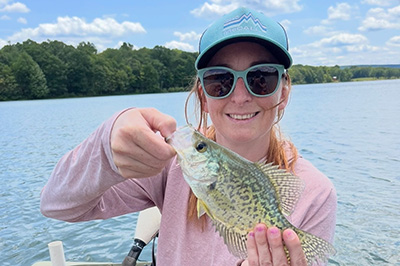
Cristina Sanders – Lake Manager
We are pleased to welcome Cristina Sanders as the new Lake Manager for Deep Creek Lake Natural Resources Management Area. Cristina was appointed to the position of Natural Resources Planner V by Maryland Park Service Director Angela Crenshaw, with her appointment effective May 14, 2025.
Cristina brings a strong background in aquatic ecology, land-use management, and interagency collaboration. She holds a Master’s Degree in Biology from Appalachian State University, with a focus on aquatic systems. Her professional experience includes work with the U.S. Fish and Wildlife Service and the Bureau of Land Management, where she focused on fisheries management, habitat restoration, environmental permitting, and outreach. Cristina is also a veteran of the United States Army, having served as a mechanic and wrecker operator.
In her free time, Cristina enjoys hiking, fishing, hunting, and spending time with her family. She also trains and competes in Muay Thai, bringing a spirit of discipline, resilience, and enthusiasm to her leadership. Cristina is eager to engage with the local community and support the stewardship of this vital public resource.
Cristina can be reached at
[email protected] or by phone at (240) 920-8766. Her office is located at the Deep Creek Lake Management Office.
Meet the 2025 Lake Management Contractual Natural Resource Technician Team
As warmer weather returns to Deep Creek Lake, we’re excited to introduce four of our dedicated contractual Natural Resource Technicians. These professionals play a vital role in supporting the lake’s health, enhancing public education and outreach, and assisting with a wide range of environmental initiatives throughout the season.
Each technician brings a unique background and set of skills to the team—from plant conservation and wildlife biology to trail building and water quality monitoring. Whether they’re reforesting buffer areas, leading habitat restoration efforts, organizing community learning events, or supporting our Launch Steward Program, their work helps protect and preserve the lake for everyone to enjoy.
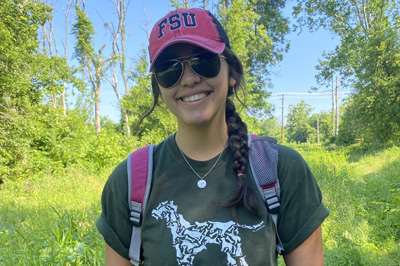
Grace Armendariz, Natural Resource Technician
Grace Armendariz returns for her second year with the Lake Management Team as a Natural Resource Technician and has stepped into a leadership role for the team. Currently pursuing a Bachelor's degree in Wildlife and Fisheries at Frostburg State University, she also holds an Associate's degree in Environmental Science and Biology from Harford Community College. Before joining the team at Deep Creek NRMA, Grace served as a Park Naturalist at both Eden Mill Nature Center and the Anita C. Leight Estuary Center. In these roles, she developed and conducted educational outreach programs, while caring for the centers' reptiles. Additionally, Grace has contributed to various research initiatives, including an eDNA study on fish communities and a metabolomics study focused on marbled salamanders. Grace is working to institute an internship program at the Lake Management Office for college students with required learning hours in the field In addition, Grace and the team will be organizing a series of virtual "Lunch and Learns" for permittees, businesses, and realtors. These sessions will cover lake management topics such as shoreline erosion control, special permits, and other relevant issues. Stay tuned for more details on this exciting new addition to the program.
Grace’s deep passion for the natural world, combined with her hands-on experience in wildlife management and education, makes her an excellent fit for supporting initiatives like habitat enhancement for the native wildlife at Deep Creek Lake. A lifelong outdoor enthusiast, Grace enjoys hiking, fishing, hunting, and birding, always seeking to connect with and protect the environment she cherishes.
Email Grace at
[email protected] or call her at (240) 920-8331
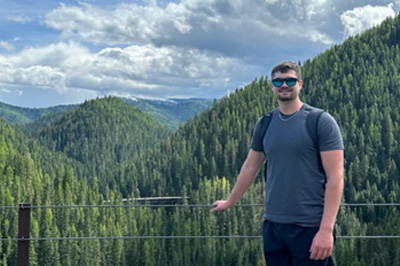
Jonas Shaffer, Seasonal Natural Resources Technician
Jonas Shaffer recently joined the Lake Management team as a Seasonal Natural Resource Technician. He graduated from Frostburg State University in 2024 with a Bachelor’s degree in Wildlife and Fisheries, where he was also a dedicated member of the university’s football team for four years. This role marks Jonas’s first professional position in the wildlife field since graduating, and he brings a strong passion for fish species and their habitats, particularly in Deep Creek Lake.
A lifelong resident of Garrett County, Jonas has spent many winters working and skiing at Wisp Resort. His deep appreciation for the outdoors began in childhood along the Savage River, where he spent countless hours fishing, hunting, and exploring the natural world. These experiences sparked a lifelong commitment to conservation and environmental stewardship, which he now brings to his work with the Lake Management team.

Anna Cullen, Seasonal Natural Resources Technician
Anna Cullen is currently a senior at West Virginia University, where she is pursuing a Bachelor’s degree in Forest Resource Management, expected to graduate in May 2026. She began her academic journey at Allegany College of Maryland, earning associate degrees in Biology and Forest Technology.
Anna brings valuable experience from her internship with the University of Maryland Center for Environmental Science at the Appalachian Laboratory in Frostburg, Maryland. During her time there, she conducted vegetation data collection at the Powdermill Avian Research Center, a research facility affiliated with the Carnegie Museum of Natural History. She also served as a Mel Fellow through the Maryland Forestry Foundation, where she contributed to promoting the Natural Resources Careers Camp—a program she previously supported as a camp counselor.
Outside of her academic and professional interests, Anna enjoys sculpting, hiking, and traveling. She was a member of the Allegany College of Maryland Woodsmen Team and currently competes with the WVU Woodsmen Team in the Mid-Atlantic Woodsmen’s Competition, participating in traditional timber sports. Her favorite events include the Jack-and-Jill saw and single buck sawing competitions.
Back to Top
